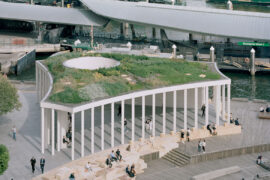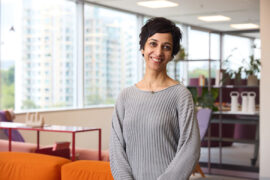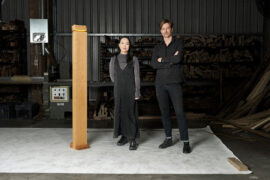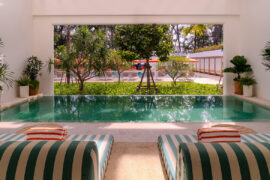Aarhus, Denmark is the backdrop for a thought-provoking new book that challenges the architectural discipline to confront issues of diversity, discrimination and inclusion.

December 16th, 2024
Building + Breaking: Eight Conversations About Spatial Justice examines architecture’s role in addressing social inequalities and imagines a more equitable future for the field. Released in September 2024 by the Danish Architectural Press, the book invites architects, academics and activists to engage with pressing ethical and societal questions.
Building + Breaking is edited by the Aarhus School of Architecture (AAA) Diversity Collaborative, comprising Joel P.W. Letkemann, Ricelli Laplace, Ruth Baumeister, Soo Jung Ryu and Urszula Kozminska. The book represents a collaborative effort to critique and expand the boundaries of architectural thought, while its varied contributors include prominent voices from academia and practice such as Jos Boys, Dorthe Staunæs and Meike Schalk.
Starting with an examination of “some of the forms of exclusion, discrimination, and violence in which the architectural discipline participates,” the book proceeds by a mode of creative critique. That is, critically engaging with architecture with a view towards opening up “new possibilities for the future of the architectural discipline.”
The book delves into the persistent challenges facing architecture as a discipline through eight distinct chapters. These address topics including gender equality, race, age, ability and economic justice, with sections titled ‘Crafting the architect-to-come,’ ‘Breaking hygge’ and ‘Queer spatial practices.” The authors argue that these difficult conversations are essential, framing critical self-reflection as both an ethical responsibility and an opportunity for growth.
The publication builds upon the work of the AAA Diversity Collaborative, a volunteer group of students and staff dedicated to intersectional allyship and anti-discrimination efforts. This collective brings a grassroots perspective to discussions about spatial justice, highlighting their commitment to creating a discipline that celebrates diversity.
The book’s chapters span a range of timely issues, from activist practices for disrupting architectural norms to rethinking architectural education. It includes perspectives on local histories of the AAA, explores the intersection of race and spatial discourse in Denmark, and examines queer spatial practices in precarious times. Contributors also emphasise the importance of fostering care and coexistence in design, advocating for a future where architecture plays a central role in addressing human and ecological concerns.
In the introduction, the editors frame the project as both a critique of architecture’s shortcomings and a hopeful vision for its potential to foster solidarity and inclusion. Elke Krasny’s preface, ‘Feminist Work is Never Done: Building the World Otherwise,’ sets the tone for the book’s commitment to reimagining the discipline.
Related: Tzannes book review

The book is published by the Danish Architectural Press, a foundation known for its influential works on Danish design and architecture since 1949. Its past publications include groundbreaking titles on Arne Jacobsen and Jan Gehl, making Building + Breaking a fitting addition to its legacy of forward-thinking architectural discourse.
Priced at €40 and spanning 168 pages, the book is available in softcover and written in English. For architects, students and anyone invested in questions of social and environmental justice, Building + Breaking is both a call to action and a roadmap for reimagining architecture’s role in the 21st century.
Danish Architectural Press was established in 1949 and, with a long history of publishing the works of the most innovative architects, designers and thinkers in Denmark, it has played an important role in shaping the history of Danish design and architecture. With Australian and Asian design often looking to the Danish tradition for inspiration, their current publications focus on global issues relevant to Danish architecture, including climate and sustainability, the challenges of urbanisation and the impact of technology on architects and designers.
Meanwhile, another recent title that design audiences will find rewarding is Building Stories by Alastair Philip Wiper, a British renowned for his work in industrial, scientific and architectural photography. This strikingly designed hardback presents a unique perspective on architecture, featuring works of architecture by Arne Jacobsen, Marcel Breuer, Santiago Calatrava and more. Wiper infuses each image with hyper-realistic colours and atmospheres, creating an intimate connection between the viewer and the buildings.
Danish Architectural Press
arkitektensforlag.dk
INDESIGN is on instagram
Follow @indesignlive
A searchable and comprehensive guide for specifying leading products and their suppliers
Keep up to date with the latest and greatest from our industry BFF's!

London-based design duo Raw Edges have joined forces with Established & Sons and Tongue & Groove to introduce Wall to Wall – a hand-stained, “living collection” that transforms parquet flooring into a canvas of colour, pattern, and possibility.

A longstanding partnership turns a historic city into a hub for emerging talent

Pier Pavilion by Besley & Spresser provides a refreshing, architecturally thoughtful and versatile public space by the water at Barangaroo.

With Steelcase having reopened its refreshed WorkLife Showroom in Singapore this year, we spoke to Navedita Shergill about some key workplace macro shifts identified in their research.
The internet never sleeps! Here's the stuff you might have missed

AHEC’s KEEP exhibition at Cult Sydney sees six Australian architects craft lasting furniture pieces, on view until 4th October.

Opening in October 2025, The Standard, Pattaya Na Jomtien brings together ONION, DIN Studio, Studio Lupine and Verena Haller to create a sculptural modernist retreat where art, architecture and coastal culture meet.